| Type | Pasta |
|---|---|
| Place of origin | Italy |
| Region or state | Sardinia |
| Main ingredients | Flour, eggs [1] |
Pillus is a type of pasta originating in the Sardinia island, particularly around Oristano. [2] A noodle-like pasta, it is made in thin ribbon strips. A feature of this pasta is that it is kneaded for a long time. [1] It is cooked in beef (or sometimes sheep) broth and served with pecorino cheese. [3] [4] In Busachi the pasta is flavoured with toasted saffron and ground to a powder. [2]
Lisanzedas is a variant of pillus (and sometimes named as such) that is oven-baked in layers like lasagne. The shape of the pasta is large (7 to 8 inches) diameter disks rather than ribbons. It is the meat stew filling and the pecorino cheese that are the common factors rather than the shape of the pasta. A variant of lisanzedas found around Cagliari is flavoured with saffron. [1] Another variant of this sort from Giba is flavoured with fennel. [4]

Pecorino romano is a hard, salty Italian cheese made with sheep's milk that is often used for grating over pasta or other dishes. The name pecorino simply means 'ovine' or 'of sheep' in Italian; the name of the cheese, although protected, is a description rather than a brand: [formaggio] pecorino romano simply means 'sheep's [cheese] of Rome'.
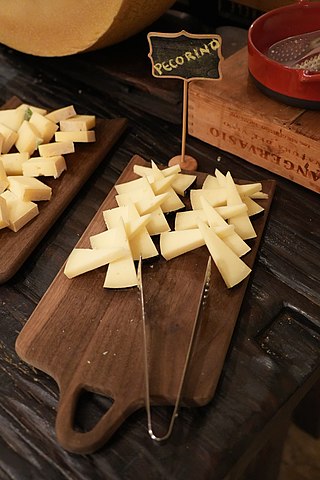
Pecorino is an Italian hard cheese produced from sheep's milk. The name pecorino derives from pecora, which means 'sheep' in Italian.

Carbonara is a pasta dish made with eggs, hard cheese, fatty cured pork, and black pepper. The dish took its modern form and name in the middle of the 20th century.
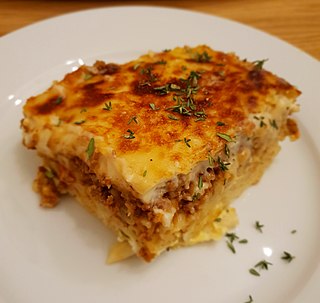
Pastitsio is a Greek baked pasta dish with ground meat and béchamel sauce, with variations of the dish found in other countries of the Mediterranean Sea.

Arrabbiata sauce, known in Italian as sugo all'arrabbiata, is a spicy sauce for pasta made from garlic, tomatoes, and dried red chili peppers cooked in olive oil. The sauce originates from the Lazio region, and particularly from the city of Rome.
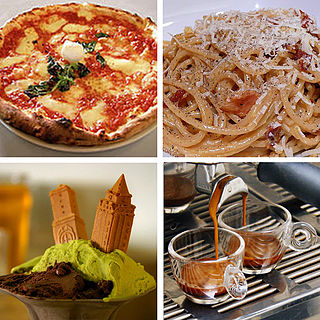
Italian cuisine is a Mediterranean cuisine consisting of the ingredients, recipes and cooking techniques developed in Italy since Roman times and later spread around the world together with waves of Italian diaspora. Some of these foods were imported from other cultures. Significant changes occurred with the colonization of the Americas and the introduction of potatoes, tomatoes, capsicums, maize and sugar beet—the latter introduced in quantity in the 18th century. It is one of the best-known and most appreciated gastronomies worldwide.

Sugo all'amatriciana, or alla matriciana, also known as salsa all'amatriciana, is a traditional Italian pasta sauce based on guanciale, pecorino romano cheese, tomato, and, in some variations, onion. Originating from the town of Amatrice, the amatriciana is one of the best known pasta sauces in present-day Roman and Italian cuisine. The Italian government has named it a traditional agro-alimentary product of Lazio and amatriciana tradizionale is registered as a traditional speciality guaranteed in the EU and the UK.

Pecorino sardo is a firm cheese from the Italian island of Sardinia, made from sheep's milk, specifically from the milk of the local Sardinian breed. It was awarded denominazione d'origine status in 1991 and granted protected designation of origin protection in 1996, the year in which this European Union certification scheme was introduced.

Spaghetti aglio e olio is a traditional pasta dish from Naples, Italy. It is a typical dish of Neapolitan cuisine and is widely popular. Its popularity can be attributed to it being simple to prepare and the fact that it makes use of inexpensive, readily available ingredients that have long shelf lives in a pantry.

The cuisine of Sardinia is the traditional cuisine of the island of Sardinia, and the expression of its culinary art. It is characterised by its own variety, and by the fact of having been enriched through a number of interactions with the other Mediterranean cultures while retaining its own identity. Sardinia's food culture is strictly divided into food from the land and food from the sea, reflecting the island's historical vicissitudes and especially its geographic landscapes, spacing from the coastline to the ragged mountains of the interior. The Sardinian cuisine is considered part of the Mediterranean diet, a nutritional model that was proclaimed by UNESCO as an intangible cultural heritage.

Roman cuisine comes from the Italian city of Rome. It features fresh, seasonal and simply-prepared ingredients from the Roman Campagna. These include peas, globe artichokes and fava beans, shellfish, milk-fed lamb and goat, and cheeses such as pecorino romano and ricotta. Olive oil is used mostly to dress raw vegetables, while strutto and fat from prosciutto are preferred for frying. The most popular sweets in Rome are small individual pastries called pasticcini, gelato and handmade chocolates and candies. Special dishes are often reserved for different days of the week; for example, gnocchi is eaten on Thursdays, baccalà on Fridays, and trippa on Saturdays.
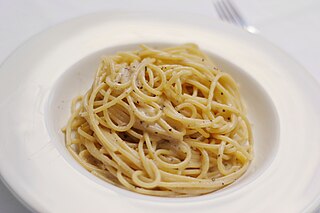
Cacio e pepe is a pasta dish typical of the Lazio region of Italy. Cacio e pepe means 'cheese and pepper' in several central Italian dialects. In keeping with its name, the dish contains grated pecorino romano and black pepper, together with tonnarelli or spaghetti. All the ingredients keep well for a long time, which made the dish practical for shepherds without fixed abode. Rough-surfaced pasta is recommended to make the sauce adhere well.

The traditional cuisine of Abruzzo is eclectic, drawing on pastoral, mountain, and coastal cuisine. Staples of Abruzzo cuisine include bread, pasta, meat, fish, cheese, and wine. The isolation which has characterized the region for centuries has ensured the independence of its culinary tradition from those of nearby regions. Local cuisine was widely appreciated in a 2013 survey among foreign tourists.
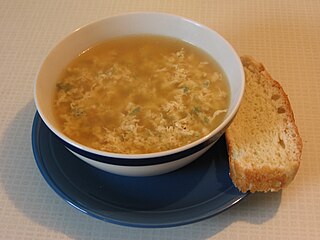
Stracciatella, also known as stracciatella alla romana, is an Italian soup consisting of meat broth and small shreds of an egg-based mixture, prepared by drizzling the mixture into boiling broth and stirring. It is popular around Rome, in the Lazio region of central Italy. A similar soup, called zanzarelli, was described by Martino da Como in his 15th century manual The Art of Cooking. Other variants exist.

Testaroli, sometimes referred to as testarolo, is a type of thin spongy pasta or bread in Italian cuisine that is prepared in circular sheets using water, flour and salt, which is then sliced into diamond or rectangular shapes. A common dish in the Lunigiana region and historical territory of Italy, it is an ancient pasta originating from the Etruscan civilization of Italy. Testaroli has been described as "the earliest recorded pasta". It is also a native dish of the southern Liguria and northern Tuscany regions of Italy.

Malloreddus, sometimes Italianized as gnocchetti sardi, are a type of pasta typical of Sardinian cuisine. They have the shape of thin ribbed shells, about 2 cm (0.79 in) long, and are made of semolina flour and water. They are usually eaten with different sauces
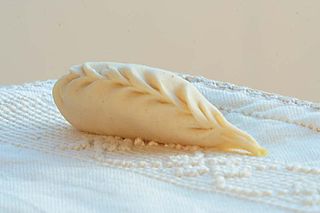
Culurgiones are a type of Sardinian ravioli-like stuffed pasta. It exists in a version made of potatoes, pecorino cheese and mint, a typical culinary specialty of the sub-region of Ogliastra, and in several other recipes adopted in the rest of the island, such as in Gallura, where the product is aromatized with lemon or orange peel.
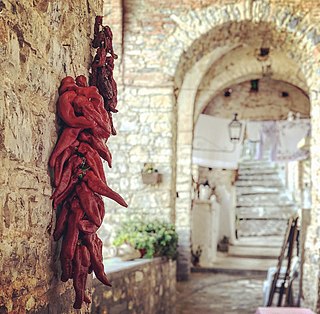
The cuisine of Basilicata, or Lucanian cuisine, is the cuisine of the Basilicata region of Italy. It is mainly based on the use of pork and sheep meat, legumes, cereals and vegetables, with the addition of aromas such as hot peppers, powdered raw peppers and horseradish. The local gastronomy is, for historical-cultural reasons, typically peasant, based on simple recipes and on the culture of reuse, in particular of meat and bread.

Cappelletti are ring-shaped Italian stuffed pasta so called for the characteristic shape that resembles a hat. Compared to tortellini, they have a different shape, larger size, thicker dough and different filling.